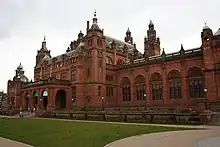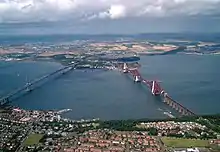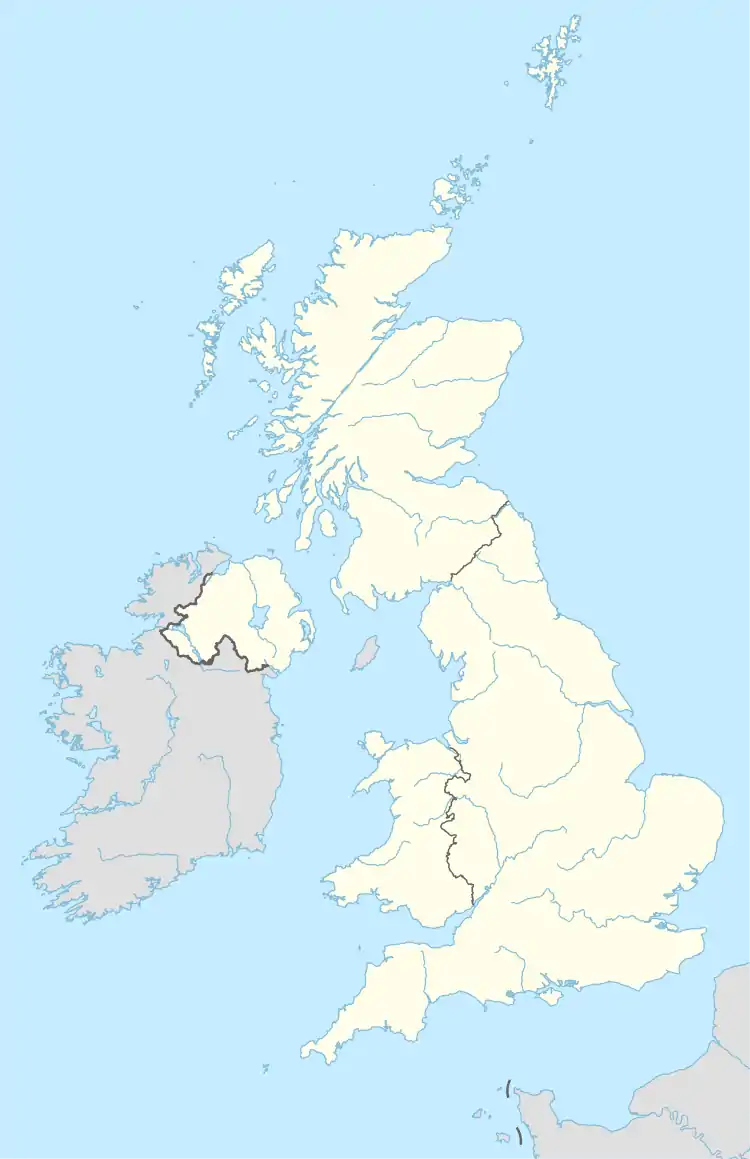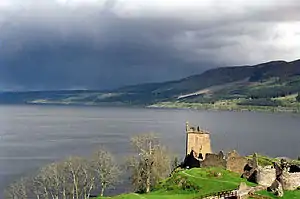Tourism in Scotland
Scotland is a well-developed tourist destination, with tourism generally being responsible for sustaining 200,000 jobs mainly in the service sector, with tourist spending averaging at £4bn per year.[1] In 2013, for example, UK visitors made 18.5 million visits to Scotland, staying 64.5 million nights and spending £3.7bn. In contrast, overseas residents made 1.58 million visits to Scotland, staying 15 million nights and spending £806m. In terms of overseas visitors, those from the United States made up 24% of visits to Scotland, with the United States being the largest source of overseas visitors, and Germany (9%), France (8%), Canada (7%) and Australia (6%), following behind.[2]








Scotland is generally seen as a destination with beautiful scenery combined with thousands of historic sites and attractions.[3] These include prehistoric stone circles, standing stones and burial chambers, and various Bronze Age, Iron Age and Stone Age remains. There are many historic castles, houses, and battlegrounds, ruins and museums. Many people are drawn by the culture of Scotland.
The main tourist season is generally from April to October. In addition to these factors, the national tourist agency, VisitScotland, have deployed a strategy of niche marketing, aimed at exploiting, amongst other things, Scotland's strengths in golf, fishing and food and drink tourism.
Statistics
Most visitors (for any purpose) to Scotland in 2018 came from the following countries:[4]
| Rank | Country | Number |
|---|---|---|
| 1 | 492,000 | |
| 2 | 451,000 | |
| 3 | 318,000 | |
| 4 | 268,000 | |
| 5 | 205,000 | |
| 6 | 172,000 | |
| 7 | 172,000 | |
| 8 | 131,000 | |
| 9 | 121,000 | |
| 10 | 106,000 | |
| Rest of the World | 1,102,000 | |
| Total overseas tourist visits | 3,538,000 |
Tourist destinations
- Edinburgh is the capital city. The Old and New Towns of the city constitute a UNESCO World Heritage Site. Edinburgh is the largest tourist destination in Scotland, and the second largest in the United Kingdom after London. The cities' major tourist attractions include Edinburgh Castle, Edinburgh Zoo, the Palace of Holyroodhouse, Our Dynamic Earth and the Royal Mile. It has four universities including the University of Edinburgh founded in 1583.
- Glasgow is the largest city in the country, and the second largest tourist destination after Edinburgh. Its attractions include the Burrell Collection, Glasgow Cathedral, the Glasgow Science Centre and the Kelvingrove Museum. In addition tourists come to Glasgow for its renowned Victorian architecture and Gothic architecture as well as its shopping. The city has three universities, including the University of Glasgow founded in 1451, and is a UNESCO City of Music which hosts the world renowned Royal Conservatoire of Scotland and Royal Scottish National Orchestra.
- Stirling is a historic city in central Scotland, 30 miles to the north-west of Edinburgh, and is generally known as the "Gateway to the Highlands", due to its geographical position between highland and lowland Scotland. Amongst its attractions are Stirling Castle, the Wallace National Monument and the Thieves Pot/Thistles Centre.
- Aberdeen is known as the "Granite City" and is renowned for its gothic architecture. It is a city of approximately 210,000 people and serves as the main administrative centre for the north-east of Scotland. With its large port and harbour, Aberdeen serves as the departure point for the ferries that connect the Scottish mainland with the Northern Isles of Orkney and Shetland. Aberdeen has two universities, and a large student population.
- St Andrews is a small, but busy town in north-east Fife. The royal burgh's economy is centred on the golf industry, with St Andrews being regarded as the home of the modern game. The University of St Andrews (the oldest in Scotland) has colleges located throughout the town and a small museum on the history of the University which is open to the public free of charge.
- Dundee is known as the "City of Discovery" and is the home of V&A Dundee, Scotland's first and only design museum. Dundee is home to Scott of the Antarctic's ship the RRS Discovery. Dundee has two universities. It has a Jute museum called Verdant Works, an Anchor Point of ERIH – The European Route of Industrial Heritage.
- Perth is a small but historic city on the east coast, which stands on the River Tay. Perth is known for its abundant parkland. Close by is the village of Scone, ancient capital of Scotland and former home to Scottish kings.
- Inverness is the administrative centre for the Highlands, close to Loch Ness and serves as a transport hub for much of the Highlands, with rail and bus services departing here to much of the northern and west Highlands. It is a popular destination for tourists wishing to explore the north of Scotland.
- Ayrshire offers wonderful scenery, outdoor activities, enthralling history with links to William Wallace, Robert the Bruce and Scotland's best known poet, Robert Burns. Ayrshire offers some of the finest golf courses in the world (32 in total). North Ayrshire hosts Kelburn Castle which is famous for its Graffiti Project.
Other areas which are popular for tourists include the Highlands and the Hebrides, such as the Isle of Skye. Perthshire, the Scottish Borders and Orkney and Shetland are popular tourism destinations.
Ben Nevis is the highest mountain in the United Kingdom, but there are many other significant mountains in Scotland, albeit relatively small by international standards. The Cuillin on the Isle of Skye offer challenging climbs such as the Inaccessible Pinnacle.
Scotland has amusement parks such as M&D's in the town of Motherwell, North Lanarkshire.
Scotland has many lochs, including Loch Lomond, and Loch Ness, home of the mythical Loch Ness monster. Rivers such as the Spey, Tay, Tweed, and Aberdeenshire Dee are famous for salmon and fly fishing. Scotland is a popular destination for hunting, especially deer and grouse.
Scotland's best known export is Scotch Whisky and numerous visitors a year enjoy a tour around its Whisky distilleries. The Highlands is by far the largest region in Scotland both in area and in whisky production. This massive area has over 30 distilleries on the mainland. When the Islands sub-region is included, the total number of distilleries is 47. [5] The nearby Speyside area has the largest number of distilleries including Aberlour, Balvenie, Cardhu, Cragganmore, Dalwhinnie,[6] Glenfarclas, Glenglassaugh, Glenfiddich, Speyburn, The Macallan, The Glenlivet, and The Glenrothes.[7][8] Distilleries are the third most visited attractions in Scotland; roughly 2 million visits were recorded in 2018. 68 distilleries operate visitors' centres in Scotland and another eight accept visits by appointment. The tourism has had an especially visible impact on the economy in some remote rural areas.[9][10]
Scotland is the home of golf, with historic and famous courses including St Andrews, Gleneagles, Royal Troon, Carnoustie, and Muirfield. There are hundreds of other courses in the country.
Effects of the Covid-19 pandemic
Like all of the UK, Scotland was negatively impacted by the restrictions and lockdowns necessitated by the worldwide COVID-19 pandemic. Tourism has particularly suffered. In October 2020, the Scottish Tourism Alliance made this comment: "The devastating impact of this pandemic will make recovery incredibly challenging, if not questionable, without the assurance of continued targeted support from both the Scottish and UK Governments".[11] The First Minister acknowledged the setbacks that the hospitality/tourism sector had already experienced in a March 2021 speech when she announced financial support for the industry. "It's been an incredibly difficult year for all businesses" and added that she did not "underestimate the acute challenges our tourism and hospitality sectors have faced".[12]
Most reports that provide statistics on the impact of the pandemic on tourism cover the entire UK as an entity rather than specifically for Scotland. VisitBritain in April 2021, stated that the travel restrictions and lockdowns in the UK led to a 76% reduction in "inbound tourism" to the UK in 2020 and forecast for 2021 indicated an estimated that visits would be up "21% on 2020 but only 29% of the 2019 level". An increase in visits was expected but slowly at first and the report concluded that tourism was not expected to come "even close to normal levels".[13]
The VisitBritain report in April 2021 discussed the effects of the pandemic on domestic within the UK in 2020, citing a significant reduction in spending, for an estimated decline of 62% over the previous year. As of January 2021, the forecast for 2021 suggested that spending would increase by 79% over the previous year and that "the value of spending will be back to 84% of 2019 levels" by the end of 2021.[14]
A report published in March 2021 by the Fraser of Allander Institute at the University of Strathclyde indicated that in the UK, "tourism and hospitality suffered notable losses from the pandemic" and provided detailed specifics for both domestic and international visits. This report reviewed the Scottish hospitality industry in great detail; the situation was not yet optimistic at that time, with "no sign of a trend reversal with more than 70% of businesses in the sector reporting lower turnover than usual".[15]
The Scottish Tourism Alliance Task Force published its recommendations in October 2020, with "Immediate Actions" for both the Scottish government and the UK government. The group particularly requested support for the tourism/hospitality industry, including financial grants, the funding of marketing for the sector, and a "temporary removal of Air Passenger Duty to boost route competitiveness".[16] On 24 March 2021, First Minister Nicola Sturgeon announced a £25 million tourism recovery programme "to support the industry for the next 6 months to two years".[17] Sturgeon reminded the hospitality/tourism industry that the government had provided "over £129 million" in support "for this sector".[18]
On 5 April 2021, the BBC published specifics about domestic tourism in the UK indicating that the restrictions were to be loosened during that month, at least for domestic travel within Scotland, Wales and England.[19] Travel within mainland Scotland was expected to be permitted again starting on 26 April. A survey in March 2021 indicated that roughly 70% of the 500 Scots surveyed were hoping to "have a holiday at home this year". The BBC recommended such "staycationing" but reminded readers that travel to "Scotland's islands or across the border at Gretna and Berwick" might not be possible for some time.[20]
The VisitBritain website discussed the UK's "COVID-19 restrictions" that were expected to be loosened in April but indicated that there was no confirmation as to whether the rules on international travel, either inbound or outbound, would actually be loosened in mid-May.[21]
It was possible that the UK's plan to loosen restrictions on inbound tourists would not commence as early as planned. On 8 April 2021 sources in the European Union stated that a "third wave of the pandemic [was sweeping] the continent". (Two days earlier, PM Boris Johnson had made it clear that "We don't want to see the virus being reimported into this country from abroad".)[22] Of particular concern was the B117 variant, a mutation of the virus, "which [was] spreading rapidly in at least 27 European countries".[23]
Travel restrictions were loosened in England on 12 April 2021, but not in Scotland. Some lockdown measures were expected to be relaxed on 26 April.[24] It was hoped that domestic travel would again be allowed and that cafes and restaurants would be permitted to re-open at least their outdoor facilities, as in England.[25]
See also
References
- "Tourism". The Scottish Government. Archived from the original on 2008-07-08. Retrieved 2006-01-10.
- "Visit Britain: Insights and Statistics". Archived from the original on 2005-12-03.
- "Scotland | ALBA". VisitScotland.
- "Key Facts on Tourism in Scotland 2018" (PDF). VisitScotland.org. September 2019.
- "TWHISKY DISTILLERIES IN THE HIGHLANDS". Visit Scotland. 11 July 2017. Retrieved 12 January 2020.
- Scotch Whisky Association 2009.
- "Speyside Distilleries – Whisky Tours, Tastings & Map". VisitScotland.
- "Breweries/Distilleries". Visit Cairngorns. 11 July 2017. Retrieved 8 December 2019.
- "Record numbers of visitors for Scotch Whisky Distilleries". 21 June 2019.
- Scotch Whisky Tourism at All-Time High
- "Tourism Recovery Recommendations". 23 October 2020. Retrieved 8 April 2021.
discussions led by Malcolm Roughead, CEO, VisitScotland, Marc Crothall, CEO, Scottish Tourism Alliance and Malcolm Buchanan, Chair of Scotland Board, RBS
- "£25 million for tourism recovery". Retrieved 8 April 2021.
We've provided an unprecedented amount of funding for the sector, including over £129 million in business suppor
- "2021 tourism forecast". 20 April 2015. Retrieved 8 April 2021.
From mid-March to mid-July, COVID-19 triggered a near-total shutdown in international tourism ... there was an increase in visitor numbers from this low point, although they remained very low, and dipped again towards the end of the year.
- "2021 tourism forecast". 20 April 2015. Retrieved 8 April 2021.
forecast assumes a slow recovery in early 2021 before a step change in the spring ... followed by a gradual recovery throughout the rest of the year and beyond.
- "Covid-19 impact on the Tourism and Hospitality Sector, an insight from the latest Economic Commentary". 18 March 2021. Retrieved 8 April 2021.
... health and economic crisis ... In particular, tourism and hospitality suffered notable losses from the pandemic.
- "Tourism Recovery Recommendations". 23 October 2020. Retrieved 8 April 2021.
It is imperative they work together with the industry to take action now in supporting and implementing the recommendations ... to rebuild our diverse businesses, to restore our thriving places and reimagine our memorable experiences.
- "First Minister announces £25 million for tourism recovery at STA conference". 24 March 2021. Retrieved 8 April 2021.
The programme, which has been developed by the Scottish Tourism Emergency Response Group (STERG) in partnership with businesses, will support the Scottish Tourism Recovery Taskforce objectives.
- "£25 million for tourism recovery". Retrieved 8 April 2021.
- "Covid: When can I go on holiday abroad or in the UK?". Retrieved 8 April 2021.
- "Covid in Scotland: Carry on staycationing". BBC News. 5 April 2021. Retrieved 8 April 2021.
If the data look ripe, mainland travel within Scotland will be allowed from 26 April. Expect a rush from the cities to the hills and the coast.
- "COVID-19 (new coronavirus) - latest information and advice for businesses". 4 November 2020. Retrieved 8 April 2021.
whether non-essential international travel can resume on 17 May, or whether we will need to wait longer before lifting the outbound travel restriction.
- "Boris Johnson refuses to set hard date for Britain to reopen for international travel". ABC News. 5 April 2021. Retrieved 8 April 2021.
Amid the coronavirus pandemic, many countries worldwide continue to restrict entry and most travel remains discouraged.
- "European travel restrictions: Nonessential travel curbed". Deutsche Welle. Retrieved 8 April 2021.
Amid the coronavirus pandemic, many countries worldwide continue to restrict entry and most travel remains discouraged.
- "Nicola Sturgeon update LIVE: Scotland lockdown Covid changes set to be announced". Retrieved 13 April 2021.
- "Covid lockdown eases: Celebrations as pub gardens and shops reopen". BBC News. 12 April 2021. Retrieved 13 April 2021.
Sources
- "The Scotch Whisky Regulations 2009: Guidance for Producers and Bottlers" (PDF). Scotch Whisky Association. 2 December 2009. Archived from the original (PDF) on 23 June 2017. Retrieved 24 September 2012.
